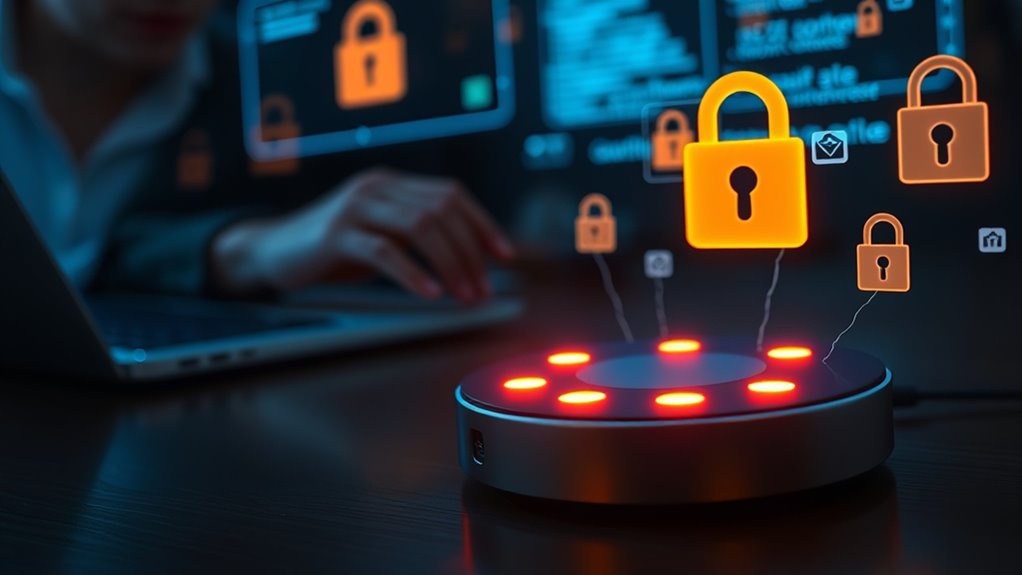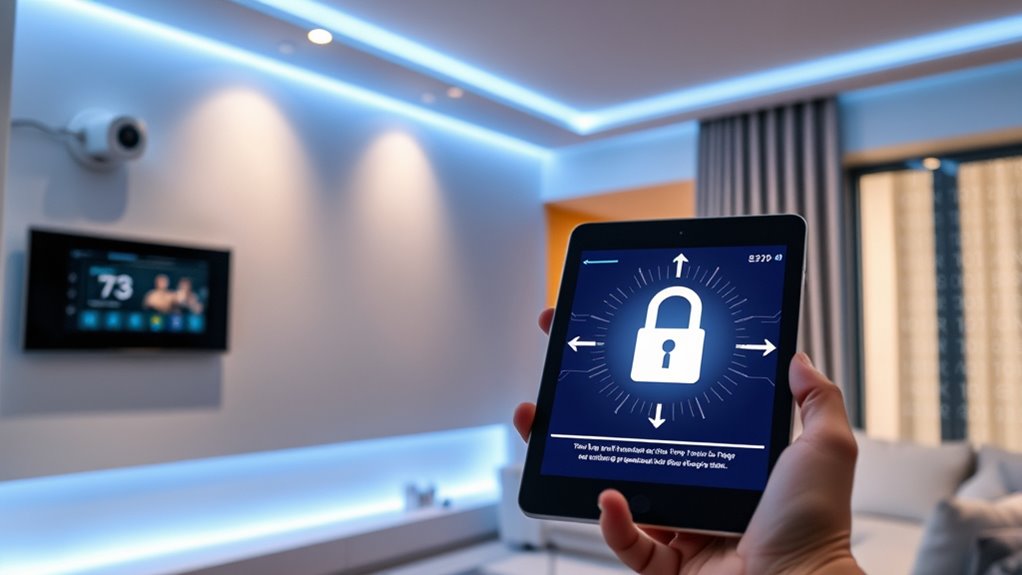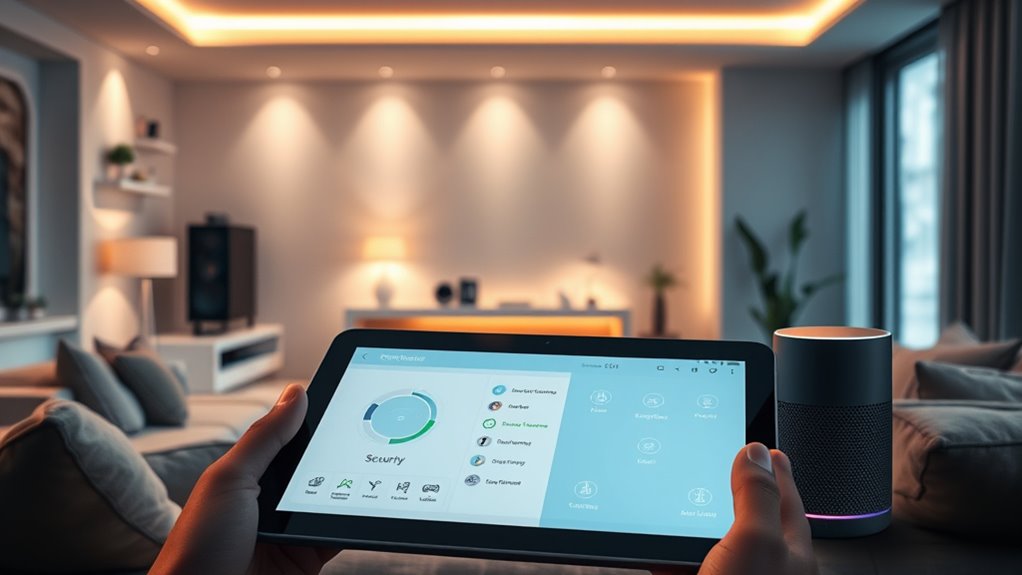As you connect more smart devices, your risk of identity theft increases because many IoT gadgets lack strong security, leaving vulnerabilities open for cybercriminals. Hackers use AI and targeted scams to exploit weak spots, especially if devices aren’t regularly updated or properly secured. Protect yourself by updating firmware, using strong, unique passwords, enabling two-factor authentication, and monitoring activity. Continuing carefully helps you understand essential steps to safeguard your personal information in an expanding digital ecosystem.
Key Takeaways
- Many IoT devices lack robust security, making them vulnerable entry points for identity theft.
- Regularly updating device firmware and software patches helps fix security flaws and protect personal data.
- Using strong, unique passwords and enabling two-factor authentication enhances device security against cybercriminals.
- Segmenting networks isolates IoT devices from critical systems, reducing the risk of widespread breaches.
- Educating users on common scams and device security best practices helps prevent identity theft via smart devices.
The Growing Threat of Identity Theft in a Digital World

As our lives become more connected through digital technology, the threat of identity theft continues to grow at an alarming rate. You’re increasingly vulnerable as cybercriminals develop smarter, more targeted scams that exploit personal data. With nearly an 85% rise in identity theft incidents over recent years, attackers are becoming more sophisticated, using AI and machine learning to craft convincing fraud attempts. Every day, someone in the U.S. faces an identity theft attempt every 4.9 seconds, highlighting how pervasive this issue has become. Cross-border fraud is also rising, driven by global digital transactions. As you conduct more activities online, your risk of falling victim to these scams increases, emphasizing the urgent need to stay vigilant and protect your personal information. The complexity of modern cyber threats underscores the importance of understanding how high-tech projectors and other connected devices can be vulnerable to cyberattacks if not properly secured. Recognizing relationship dynamics can also play a crucial role in understanding the social engineering tactics used by cybercriminals to manipulate individuals. Additionally, the proliferation of Internet of Things devices amplifies the potential attack surface for cybercriminals seeking to access personal data. Furthermore, awareness of cybersecurity best practices is essential to defend against these evolving threats.
Understanding IoT Vulnerabilities and Their Impact

The rapid proliferation of Internet of Things (IoT) devices has introduced new vulnerabilities that cybercriminals are keen to exploit. These devices often lack strong security features, making them easy targets for hackers. With about 820,000 hacking attempts daily, the attack volume highlights the scale of the threat. Many IoT devices don’t have regular security updates or robust encryption, leaving personal and financial data exposed. Cybercriminals can hijack these devices as proxies to carry out financial crimes or access sensitive information. The interconnected nature of IoT means a single compromised device can serve as an entry point for broader network breaches. As threats evolve rapidly, understanding these vulnerabilities helps you recognize how they impact your privacy and financial security. For instance, some IoT devices, like smart thermostats or security cameras, are known for security weaknesses, which can be exploited by attackers to gain access to your network. Implementing security best practices for IoT devices can help mitigate these risks and protect your digital life. Additionally, staying informed about common IoT vulnerabilities enables users to better anticipate and defend against potential attacks. Recognizing the potential for device exploitation underscores the importance of proactive security measures in safeguarding your connected devices. Moreover, fostering awareness about vulnerable devices can encourage better security habits among users.
How High-Net-Worth Individuals Are Targeted

High-net-worth individuals are prime targets because their valuable assets and sensitive information are easily exploited through IoT vulnerabilities. Cybercriminals use asset targeting strategies to access financial accounts, smart homes, and personal data. To stay protected, you need enhanced security measures tailored to defend against these sophisticated, high-stakes threats. Implementing effective sound recording techniques can also help monitor and detect unusual activities within your smart environments. Additionally, understanding the privacy and consent management of connected devices is crucial for maintaining control over your personal information. Incorporating automated data analysis can further identify potential breaches early and prevent significant damage. Recognizing the importance of device security standards ensures your smart devices are resilient against potential breaches.
Asset Targeting Strategies
Cybercriminals actively target high-net-worth individuals because their valuable assets and sensitive information make them prime targets. They use specific asset targeting strategies to maximize their chances of success:
- Compromising smart home devices to access private data and control systems, revealing financial details and personal routines. For example, exploiting sleep patterns or daily habits can assist in planning effective attacks. Understanding the security vulnerabilities associated with these devices is crucial for protection. Additionally, many of these devices rely on cloud connectivity, which, if not properly secured, can be exploited by attackers. Being aware of cookie categories and managing user consent can also help mitigate unauthorized data access.
- Phishing campaigns tailored to their financial holdings, exploiting social engineering to gain login credentials.
- Exploiting connected financial tools like smart investment platforms or banking apps for direct access to accounts.
- They often utilize vibrational energy principles to identify and exploit the vulnerabilities associated with high-stakes targets.
Enhanced Security Needs
As digital threats become more sophisticated, high-net-worth individuals must adopt enhanced security measures to protect their valuable assets. Cybercriminals target HNWIs because of their wealth and sensitive information, especially through IoT devices that often lack strong security. These devices can be hijacked to access personal data, financial accounts, or even smart home systems. Regular updates, strong passwords, and two-factor authentication are essential. Segmenting networks and monitoring device activity reduce attack surfaces. Education about potential risks helps prevent human errors. As threats evolve with AI and cross-border tactics, staying ahead requires continuous security improvements. Investing in advanced cybersecurity solutions and collaborating with experts guarantees you’re better protected against increasingly targeted IoT vulnerabilities. Additionally, incorporating self-awareness can help individuals recognize and respond to potential security threats proactively.
Key Security Challenges Facing IoT Ecosystems

Securing IoT ecosystems presents several key challenges that hinder efforts to protect connected devices and data. First, many devices lack standardized security protocols, making it difficult to guarantee consistent protection across the network. Second, managing an accurate inventory of all IoT devices is tough, leaving gaps in security coverage. Third, the rapid evolution of threats means security measures often lag behind attackers’ tactics. These issues create a larger attack surface and increase vulnerability. Additionally, IoT devices are often less secure than traditional systems, making them prime targets for cybercriminals. As threats grow more sophisticated, especially with AI-driven attacks, addressing these challenges becomes essential to safeguarding your smart devices and personal information effectively. Incorporating sound healing science and innovative security techniques can help develop more resilient IoT systems. Moreover, leveraging payment processing security insights can inform better protection strategies for IoT payment devices and transactions. Recognizing the importance of industry standards can also drive the development of more uniform and robust security measures across devices.
Practical Strategies to Protect Your Smart Devices

To protect your smart devices, start by keeping their firmware updated regularly to fix security flaws. Use strong, unique passwords for each device, and enable two-factor authentication whenever possible. These simple steps can considerably reduce your risk of falling victim to IoT-related identity theft.
Regular Firmware Updates
Regular firmware updates are one of the most effective ways to protect your smart devices from cyber threats. They fix security vulnerabilities that hackers can exploit, keeping your devices secure. To maximize protection, consider these steps:
- Enable automatic updates whenever possible, so your device receives patches as soon as they’re available.
- Regularly check for firmware updates manually through your device’s app or settings menu.
- Keep a record of update dates to guarantee your devices stay current and secure over time.
Strong Password Practices
Strong passwords are a key line of defense for your smart devices, helping prevent unauthorized access even if other security measures like firmware updates are in place. To protect your devices, create unique, complex passwords that include a mix of uppercase and lowercase letters, numbers, and symbols. Avoid common words or predictable patterns, such as “password123” or your pet’s name. Use a password manager to generate and store strong passwords securely, so you don’t have to remember each one. Enable two-factor authentication whenever possible, adding an extra layer of security. Regularly review and update your passwords, especially after any security breach. By practicing these strong password habits, you *considerably* reduce the risk of cybercriminals hijacking your smart devices and compromising your personal information.
The Future of IoT Security and Emerging Risks

As the number of IoT devices continues to grow exponentially, the security landscape faces increasingly complex challenges. You’ll need to stay ahead of evolving risks, as threats become more sophisticated with AI and machine learning. Three emerging risks to watch include:
- Expanded Attack Surfaces: More devices mean more vulnerabilities, making exhaustive management essential.
- Advanced Cyber Threats: Hackers leverage AI to craft personalized, harder-to-detect attacks.
- Regulatory Changes: Governments are developing new standards, requiring ongoing compliance efforts.
To protect your smart devices, you must prioritize regular updates, network segmentation, and user education. Staying aware of these trends helps you mitigate risks before they escalate, ensuring your connected environment remains secure amid rapid technological advancements.
Building a Safer Digital Environment for All

Creating a safer digital environment requires proactive strategies to protect your devices and personal information from evolving threats. Start by regularly updating your device firmware and software to patch security vulnerabilities. Use strong, unique passwords for each device and enable two-factor authentication whenever possible. Segment your network to isolate IoT devices from your main systems, reducing the risk of widespread breaches. Keep an inventory of all connected devices to monitor for unauthorized access. Educate yourself about common scams and security best practices, so you recognize potential threats early. Implement robust device management tools to oversee your network’s security. By staying vigilant and proactive, you can minimize vulnerabilities and create a safer digital space for yourself and others.
Frequently Asked Questions
How Can Legal Regulations Help Prevent Iot-Related Identity Theft?
Legal regulations can help prevent IoT-related identity theft by establishing clear security standards for device manufacturers, ensuring they implement robust protections. They can enforce mandatory data encryption, regular security updates, and user authentication protocols. Additionally, regulations can require transparency about data collection and sharing, empowering you to better understand and control your personal information. These measures create accountability, reduce vulnerabilities, and help protect your identity from cybercriminals exploiting IoT devices.
What Role Does Artificial Intelligence Play in Iot Security Breaches?
Imagine AI as a double-edged sword, slicing through cyber defenses and cutting both ways. It enables cybercriminals to craft personalized, convincing scams, penetrating IoT devices with ease. AI also automates attacks, making breaches faster and more sophisticated. You must stay vigilant, applying advanced security measures, because as AI advances, so do the threats, turning your smart devices into battlegrounds for unseen digital warfare.
Are There Specific Cybersecurity Tools Designed for High-Net-Worth Individuals?
Yes, there are cybersecurity tools tailored for high-net-worth individuals. You can use advanced threat detection systems, like personalized intrusion detection, to monitor your smart devices and networks. Multi-factor authentication adds an extra layer of protection for your accounts. Additionally, employing secure VPNs, regular security audits, and dedicated security consulting help safeguard your assets and personal data from cybercriminals targeting high-net-worth individuals.
How Does Cross-Border Data Transfer Affect Iot Vulnerability Management?
When you transfer data across borders, it complicates IoT vulnerability management by expanding the attack surface and introducing varied regulations. You might face inconsistent security standards and enforcement, making it easier for cybercriminals to exploit weaknesses. To protect your devices, you need to implement robust security protocols, stay updated on international regulations, and collaborate with global partners. This approach helps guarantee your IoT devices remain secure despite the complexities of cross-border data movement.
What Are the Best Practices for Companies to Standardize Iot Security Protocols?
You should implement standardized security protocols across all IoT devices, including consistent firmware updates and security configurations. Use industry best practices for device authentication and encryption, and establish clear guidelines for device onboarding and management. Regularly audit and monitor your IoT network for vulnerabilities, and ensure staff are trained on security procedures. Collaborate with industry groups to adopt evolving standards, reducing risks and enhancing your overall IoT security posture.
Conclusion
As you navigate the connected world, remember that securing your smart devices is like locking every door in your digital home. By staying vigilant, updating your security measures, and understanding potential risks, you can turn the tide against identity thieves. Think of your IoT ecosystem as a fortress—stronger defenses mean fewer breaches. Stay proactive and guard your digital life, so your smart devices remain a safe haven rather than an open door for cybercriminals.









